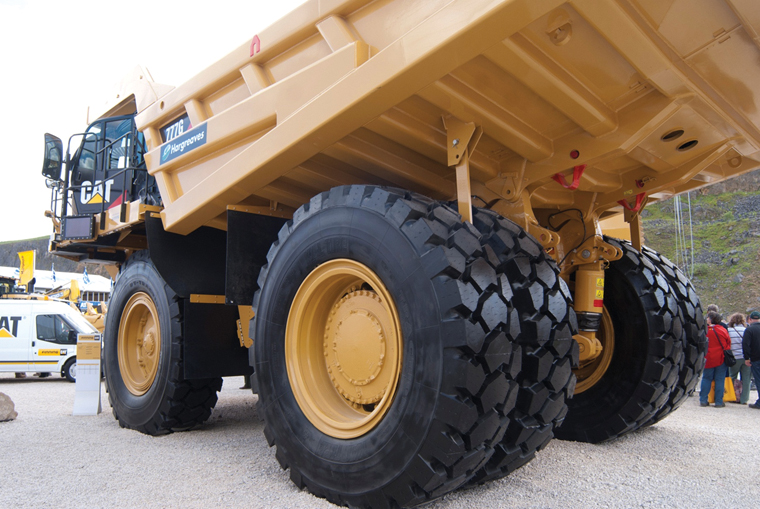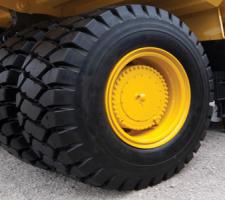
Getting the most from tyres is a critical exercise and one that can either save money or cost dearly. Dan Gilkes reports
Tyres are without doubt one of the most expensive wear parts of any wheeled machine. Along with fuel and operators, they make up a considerable percentage of the ownership and operating cost of any truck or loader.
When you get into quarry-sized tyres the costs just keep on rising. Getting the most from those black rings of rubber is therefore a critical exercise and one that can either save you money or cost you dearly.
Tyre choice, haul road maintenance, tyre protection, planned retreading: all can contribute to the efficiency of your operation.
Tyre manufacturers are playing their part, developing improved designs and compounds that last longer and work more efficiently.
Earlier this year at the
The XADN+ range will replace the XADN, which has proven popular since its introduction in 1996. The revised tyre offers more damage-resistant sidewalls, a more durable tread, thanks to optimised bracing plies and casings, and greater longevity.
Michelin says the XADN+ should offer an 8-15% increase in tyre life, thanks in part to the new rubber compound. It will also be available in sizes to suit 25, 30 and 35tonne ADTs by mid-2013.
The revised compound uses 14kg less natural raw material per tyre than its predecessor. This reduction in overall use of raw materials preserves natural resources, particularly important when there has been a global shortage of the resource.
The company has also introduced a wider wheeled loader tyre in the 600/65R25 size. Intended for all-season performance, the VSW tyre offers a wider contact surface than a conventional 20.5R25, delivering improved stability and reduced ground pressure.
Michelin has also added to its X-Traction range of tyres for rigid dump trucks. First seen on larger trucks in a 27.00R49 size in 2004, Michelin has now launched both 35 and 33inch tyres for smaller quarry trucks.
To deal with the higher speeds achieved by smaller rigid trucks, the X-Traction has a new cooling system shoulder design, along with the company’s C2 Technology casing architecture.
Both of these technologies are intended to prevent heat build-up within the tyre, allowing higher operating speeds without the risk of tyre degradation.
Michelin claims that the X-Traction in 24.00R35 size is also considerably lighter than its previous XDT design, and can contribute up to 5% fuel consumption saving.
This is despite a tyre tread that is 7-9mm deeper, which can extend tyre life by up to 15% thanks to improved resistance to cuts and scrapes.
Perhaps unfamiliar to some in the quarry business,
Already popular in the agricultural sector, the company is increasingly turning its attention to the quarry market and is looking for additional distributors.
At the recent
Though few tyre manufacturers are directly involved in retread work, one of Europe’s leading specialists,
The company recently introduced a 27.00R49 with its toughest W2 compound for 100tonne rigid dump trucks. Demand for large tyres of 49inches and above is particularly high across the world at present, due to the booming worldwide demand for large trucks in the mining industry.
“For the rigid dump truck business our range goes up to a measurement of 36.00R51 for dump trucks with a capacity of over 100tonnes,” says Luca Mai, the company’s executive sales manager.
“We are able to offer various compounds depending on the market application, from compounds that are especially formulated to withstand cuts, such as the W2, to those that offer maximum resistance against heat and high velocity, such as the H1.”
Reducing cost per hour, or cost per tonne, has never been as critical as it is at present and quarry operators are examining every opportunity to reduce their costs. Though delivering a shorter life than a new premium tyre, a retread can save the customer literally thousands of pounds.
“When managing tyres, being able to maximise both the efficiency and return of the initial investment made at the time of purchase becomes the most important objective,” says Mr Mai. He pointed out that the Marangoni offering provides users of earthmoving tyres the maximum available on the market in terms of both retreading technology and compound quality, with a range of 267 different products, divided between 73 sizes and 38 profiles.
“Marangoni distributes its retreaded earthmoving tyres through a network of specialists, offering users a complete service and expert advice,” says Mai.
“Ultimately, it’s about being able to get the best hourly cost. In order to achieve this, being able to understand when and if a tyre can be retreaded and repaired becomes essential.
“The prediction that there will be a shortage of new, premium OTR/EM tyres in 2012 now seems indisputable. Europe’s general economic situation is on everyone’s mind and the need to save money has become imperative for all users. If correctly managed, even the largest tyre can be retreaded for less than 40 to 50% than the cost of a new, premium tyre. This clearly represents a substantial amount in terms of savings for the user.”
Of course getting maximum use from a tyre will, when necessary, mean having a tyre repaired. There are a number of companies who specialise in tyre repairs for heavy earthmoving equipment, though it is always difficult for a customer to know exactly what has been done and more importantly how well a repair has been carried out.
To combat this manufacturers have been introducing accreditation schemes, as a way of demonstrating to customers what repair companies can provide an audited and accredited repair service.
Michelin joined forces with tyre repair equipment and materials supplier Rema Tip Top two years ago, to provide an accreditation scheme for the repair of its heavy tyres. At present there are three specialists in the UK accredited to the programme, which will now be rolled out throughout Europe.
“Tyres are designed to be repairable,” says Michelin’s technical manager Jock Aitken. “But there has never been a British standard for off-road tyre repairs.”
By auditing tyre repair companies, and insisting on pre-set processes and techniques, Michelin can be sure that customers are getting a repair that will go the distance.
“The warranty says that the repair will last the life of the tyre,” says Mr Aitken.
Bridgestone has also set up a European programme, called Bridgestone Elite, to show the best dealers for service.
“The initiative started in France as a pilot in 2008 and it is now also in Germany. There are plans to develop it across the EU,” says Bridgestone’s senior European communications manager Gert Meylemans.
“At the moment there are 250-300 outlets as part of this programme. The benefit for the customer is to have the best service from experienced staff using the best materials. Dealers are recommended and audited by Bridgestone to ensure a constant service.”
Perhaps the biggest change to the off-highway tyre market is still to come however. Following the lead of the on-highway truck and bus markets, an increasing number of customers are asking whether they actually need to own their tyres at all anymore.
Heavy equipment dealers are being asked to provide lease purchase and contract hire deals, and extending those deals to include ground engaging equipment and tyres is a natural move.
“It has been successful on road-going machines,” says Mr Aitken, “But we need more knowledge before it will happen in quarries. In the next few years we will see it coming in though.”
UK
Caterpillar’s latest 777G rigid truck for instance already comes with tyre pressure warning devices built-in, along with electronic monitoring systems for the truck’s major components.
“We can measure haul road conditions through the machine from our head office site in Cannock [County Staffordshire, England],” says mining sales manager Eric Brindley. “That includes haul road analysis, control measures within the machine, travel speeds, cambers of the road, gear changes. The first sign of something going wrong is usually seen in the tyres.
Planning ahead, constantly monitoring performance and condition, and making tyre maintenance an integral part of machine operation, is therefore the only way to ensure maximum life and lowest operating cost.
Sideflex shields sidwealls
In mining, quarrying and some earthmoving applications, dump trucks used to carry material from the working face to the processing plant rely on large, expensive earthmover tyres to carry out their tasks.
Depending on site conditions, these tyres can be subject to poor traction, abrasive attrition and sidewall damage.
Poor traction due to soft, clay conditions or iced up haul roads is a safety issue. Tyre abrasion is an asset issue, according to German company RUD-Erlau, which has introduced its Sideflex product.
It says that abrasion can rapidly destroy tyres, leading to premature and costly replacement.
“Nowadays truck operators overcome both these problems by adopting the same remedies used to protect the tyres of wheeled loaders, bulldozers and graders.
“Fitting a suitably-patterned, durable set of tyre protection or traction chains to the truck’s drive wheels provides extra grip and absorbs the abrasion: doubling and trebling tyre life.
“For trucks there still remains the risk of sidewall damage from sharp flints and shale-like debris and, once damaged in this way, the weakened tyre becomes a write-off with no possibility of extended life as a remould.
“Although haul roads are regularly cleared of spills and rock falls, it only takes one stray flint to instantly destroy a tyre and disable a truck with the consequent interruption to productivity.
“With loaders, dozers and graders tyres it is accepted practice to protect tyres from sidewall damage with an impenetrable, tight-meshed chain but while in extreme conditions, TPCs (tyre protection chains) have been tried with dump trucks, the long travelling distances involved make this solution impracticable and short-lived.”
Due to feedback from its TPC engineers, RUD-Erlau was well aware of the vulnerability of dump truck tyres and asked its R&D team to tackle the problem.
The team developed Sideflex, where a sturdy set of replacement wheel nuts and extensions support a simple steel ring to which is attached a fanned array of over-lapping platelets, which shield the entire sidewall of the truck tyre deflecting rock fragments away.
“While the mounting components are made of steel, the Sideflex shield is manufactured from a sophisticated engineering polymer which has found many applications in the automotive and other industries.
“This robust material, which is used to protect automobiles, has a memory capability that enables the platelets to flex and deform on impact and then return to their original shape without any loss of integrity.”
















